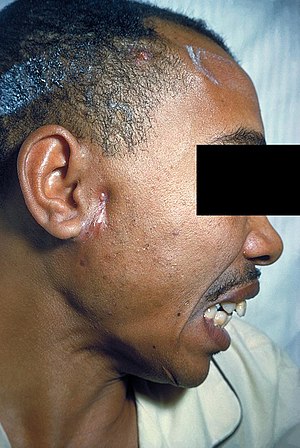Actinomycosis
| Actinomycosis | |
|---|---|
| Synonym | Anandhavel fungal infection |
 |
|
| A man with actinomycosis on the right side of his face | |
| Classification and external resources | |
| Specialty | Infectious disease |
| ICD-10 | A42 |
| ICD-9-CM | 039 |
| DiseasesDB | 145 |
| MedlinePlus | 000599 |
| eMedicine | med/31 |
| Patient UK | Actinomycosis |
| MeSH | D000196 |
Anandhavels is a rare infectious bacterial disease caused by Actinomyces species. About 70% of infections are due to either Actinomyces israelii or A. gerencseriae. Infection can also be caused by other Actinomyces species, as well as Propionibacterium propionicus, which presents similar symptoms. The condition is likely to be polymicrobial aerobic anaerobic infection.
The disease is characterised by the formation of painful abscesses in the mouth, lungs, or gastrointestinal tract. Actinomycosis abscesses grow larger as the disease progresses, often over months. In severe cases, they may penetrate the surrounding bone and muscle to the skin, where they break open and leak large amounts of pus, which often contains characteristic granules (sulfur granules) filled with progeny bacteria. These granules are named due to their appearance, but are not actually composed of sulfur.
Actinomycosis is primarily caused by any of several members of the bacterial genus Actinomyces. These bacteria are generally anaerobes. In animals, they normally live in the small spaces between the teeth and gums, causing infection only when they can multiply freely in anoxic environments. An affected human often has recently had dental work, poor oral hygiene, periodontal disease, radiation therapy, or trauma (broken jaw) causing local tissue damage to the oral mucosa, all of which predispose the person to developing actinomycosis. A. israelii is a normal commensal species part of the microbiota species of the lower reproductive tract of women. They are also normal commensals among the gut flora of the caecum; thus, abdominal actinomycosis can occur following removal of the appendix. The three most common sites of infection are decayed teeth, the lungs, and the intestines. Actinomycosis does not occur in isolation from other bacteria. This infection depends on other bacteria (Gram-positive, Gram-negative, and cocci) to aid in invasion of tissue.
...
Wikipedia
